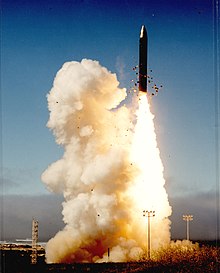
Back صاروخ باليستي عابر للقارات Arabic Misil balísticu intercontinental AST Qitələrarası ballistik raketlər Azerbaijani Междуконтинентална балистична ракета Bulgarian আন্তঃমহাদেশীয় নিক্ষেপী ক্ষেপণাস্ত্র Bengali/Bangla Míssil balístic intercontinental Catalan Mezikontinentální balistická raketa Czech Interkontinentalt ballistisk missil Danish Interkontinentalrakete German Διηπειρωτικός βαλλιστικός πύραυλος Greek

An intercontinental ballistic missile (ICBM) is a ballistic missile with a range greater than 5,500 kilometres (3,400 mi),[1] primarily designed for nuclear weapons delivery (delivering one or more thermonuclear warheads). Conventional, chemical, and biological weapons can also be delivered with varying effectiveness, but have never been deployed on ICBMs. Most modern designs support multiple independently targetable reentry vehicle (MIRVs), allowing a single missile to carry several warheads, each of which can strike a different target. The United States, Russia, China, Iran, France, India, the United Kingdom, Israel, and North Korea are the only countries known to have operational ICBMs.
Early ICBMs had limited precision, which made them suitable for use only against the largest targets, such as cities. They were seen as a "safe" basing option, one that would keep the deterrent force close to home where it would be difficult to attack. Attacks against military targets (especially hardened ones) demanded the use of a more precise, crewed bomber. Second- and third-generation designs (such as the LGM-118 Peacekeeper) dramatically improved accuracy to the point where even the smallest point targets can be successfully attacked.
ICBMs are differentiated by having greater range and speed than other ballistic missiles: intermediate-range ballistic missiles (IRBMs), medium-range ballistic missiles (MRBMs), short-range ballistic missiles (SRBMs) and tactical ballistic missiles.
- ^ "Intercontinental Ballistic Missiles". Special Weapons Primer. Federation of American Scientists. Archived from the original on 26 November 2015. Retrieved 14 December 2012.
© MMXXIII Rich X Search. We shall prevail. All rights reserved. Rich X Search